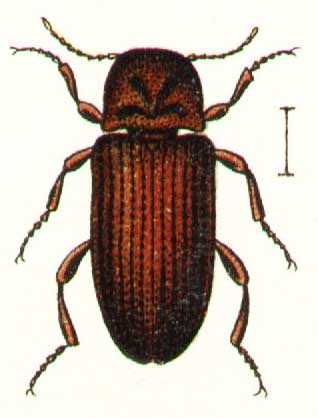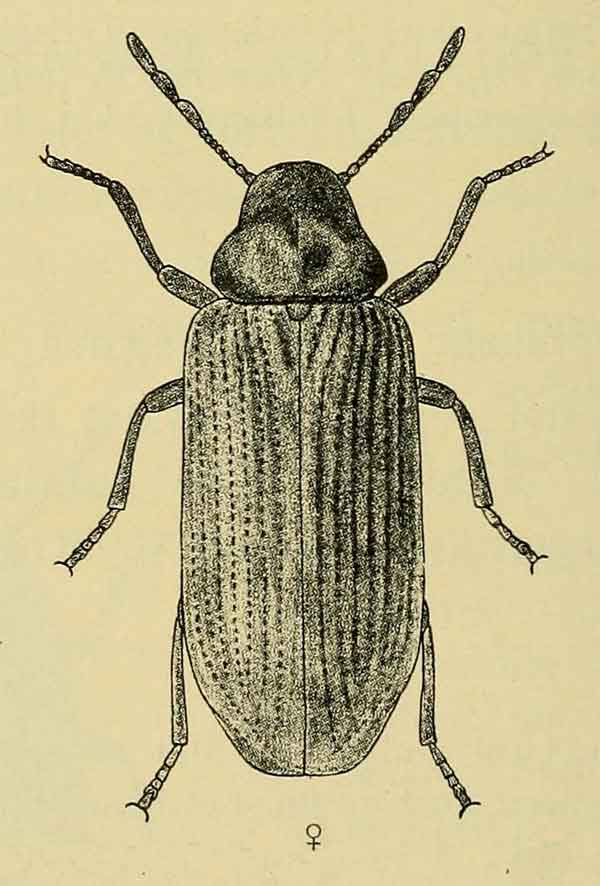
Anobium punctatum
Superregnum: Eukaryota
Cladus: Unikonta
Cladus: Opisthokonta
Cladus: Holozoa
Regnum: Animalia
Subregnum: Eumetazoa
Cladus: Bilateria
Cladus: Nephrozoa
Cladus: Protostomia
Cladus: Ecdysozoa
Cladus: Panarthropoda
Phylum: Arthropoda
Subphylum: Hexapoda
Classis: Insecta
Cladus: Dicondylia
Subclassis: Pterygota
Cladus: Metapterygota
Infraclassis: Neoptera
Cladus: Eumetabola
Cladus: Endopterygota
Superordo: Coleopterida
Ordo: Coleoptera
Subordo: Polyphaga
Infraordo: Bostrichiformia
Superfamilia: Bostrichoidea
Familia: Ptinidae
Subfamilia: Anobiinae
Tribus: Anobiini
Genus: Anobium
Species: Anobium punctatum
Name
Anobium punctatum De Geer, 1774
Synonymy
Ptinus punctatum De Geer, 1774
Anobium amplicolle Broun, 1880
Anobium caelatum Mulsant & Rey, 1864
Ptinus cylindricum Marsham, 1802
Birrhus domesticus Geoffroy in Fourcroy, 1785
Anobium latreillei Dufour, 1843
Hadrobregmus pumilum LeConte, 1865
Anobium ruficolle Herbst, 1793
Anobium ruficorne Broun, 1880
Anobium striatum Olivier, 1790

References
Kuschel, G. 1990: Beetles in a suburban environment: a New Zealand case study. DSIR Plant Protection report, (3) PDF
Links
Anobium punctatum – Taxon details on Integrated Taxonomic Information System (ITIS).
Anobium punctatum De Geer, 1774 Taxon details on Fauna Europaea
Vernacular names
বাংলা: ঘুণ পোকা
dansk: Almindelig borebille
Deutsch: Gemeiner Nagekäfer
English: Common furniture beetle
Nordfriisk: Holtwirem
français: Petite vrillette
italiano: Tarlo
Nederlands: Gewone houtwormkever
polski: Kołatek domowy
русский: Шашель / Мебельный точильщик
slovenščina: navadni trdoglavec / kukec / mrtvaška ura
The common furniture beetle or common house borer (Anobium punctatum) is a woodboring beetle originally from Europe[1] but now distributed worldwide. In the larval stage it bores in wood and feeds upon it. Adult Anobium punctatum measure 2.7–4.5 millimetres (0.11–0.18 in) in length. They have brown ellipsoidal bodies with a prothorax resembling a monk's cowl.[2]
Life cycle
The female lays her eggs in cracks in wood or inside old exit holes, if available. The eggs hatch after some three weeks, each producing a 1 millimetre (0.039 in) long, creamy white, C-shaped larva. For three to four years the larvae bore semi-randomly through timber, following and eating the starchy part of the wood grain, and grow up to 7 millimetres (0.28 in). They come nearer to the wood surface when ready to pupate. They excavate small spaces just under the wood surface and take up to eight weeks to pupate. The adults then break through the surface, making a 1 mm to 1.5 millimetres (0.059 in) exit hole and spilling dust, the first visible signs of an infestation. After they emerge, the adults do not feed; they find mates, reproduce, and die.
Pest control
Woodworm holes and burrows exposed in wooden floorboard
The first step in pest control is prevention. Particularly important in this respect is to keep the timber dry - below 16% moisture content. A relative humidity within the building above 60% may lead to an infestation, and timber moisture content below 12% is too dry for an infection to occur.[3] Anobium punctatum normally only attacks seasoned sapwood timber, not live or fresh wood. Also, it usually does not attack heartwood timbers. This is readily observed from infested structures, where one piece of timber may be heavily attacked but an adjacent one left virtually untouched according to whether it is made from the heartwood or the sapwood part of a tree trunk. Infestations are also usually a problem of old wooden houses built with untreated timbers. Some building regulations state that timbers with more than 25% sapwood may not be used, so that wood borer infections cannot substantially weaken structures.
Infection, past or present, is diagnosed by small round exit holes of 1 to 1.5 mm diameter. Active infections feature the appearance of new exit holes and fine wood dust around the holes.
Because of the 3–4 year life cycle of Anobium punctatum, timber or timber products bought containing an A. punctatum infection may not manifest holes until years after the timber has been acquired. Infestation can be controlled by application of a residual insecticide (such as permethrin) to infected areas, by professional fumigation, or by replacing infected timber .[4] Simple aerosol insecticide sprays will only kill the adult borer on the wing but not the burrowing larvae, which remain relatively protected inside infected timbers. Freezing infected timber, or heating to 50 °C for a day or more, will kill beetle larvae, but offer no residual protection.
See also
Woodworm
References
"House borer". Manaaki Whenua. Retrieved 2021-06-12.
"Pest Control of Timber Borers". Fumanest Group. 2006-10-22.
"Woodworm Anobium Punctatum". Cathedral Communications Limited.
"Anobium punctatum (Anobiidae)". University of British Columbia.
Retrieved from "http://en.wikipedia.org/"
All text is available under the terms of the GNU Free Documentation License

